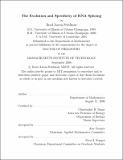The evolution and specificity of RNA splicing
Author(s)
Friedman, Brad Aaron
DownloadFull printable version (4.029Mb)
Alternative title
Evolution and specificity of ribonucleic acid splicing
Other Contributors
Massachusetts Institute of Technology. Dept. of Mathematics.
Advisor
Christopher B. Burge.
Terms of use
Metadata
Show full item recordAbstract
The majority of human genes are not encoded in contiguous segments in the genome but are rather punctuated by long interruptions known as introns. These introns are copied from generation to generation, and even from cell to cell as a person grows from an embryo into an adult. Each time a gene is activated, the cell must first accurately excise all the introns in a process known as splicing. This excision is determined by the sequence of the gene, but in a complicated way that is not fully understood. By analyzing gene sequences we can learn about how cells decide which sequences to splice. We have developed two new mathematical models, one for the end of introns, and another for long distance interactions between different parts of genes, that expose previously unknown elements potentially involved in the splicing reaction. However their boundaries are determined, introns are very ancient: although they are absent from bacteria they are found in almost all protists, fungi, plants and animals. It is therefore of great interest to explain their evolutionary origins. We have developed a probabilistic model for the evolution of introns and used it to perform a genome-wide analysis of the patterns of intron conservation in four euascomycete fungi, establishing that intron gain and loss are constantly reshaping the distribution of introns in genes.
Description
Thesis (Ph. D.)--Massachusetts Institute of Technology, Dept. of Mathematics, 2006. This electronic version was submitted by the student author. The certified thesis is available in the Institute Archives and Special Collections. Includes bibliographical references (p. 119-125).
Date issued
2006Department
Massachusetts Institute of Technology. Department of MathematicsPublisher
Massachusetts Institute of Technology
Keywords
Mathematics.